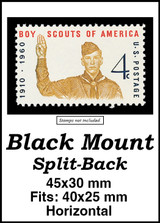
3¢ Battle of Brooklyn
City: Brooklyn, NY
Quantity: 116,130,000
Printed by: Bureau of Engraving and Printing
Printing Method: Rotary Press
Perforations: 11 x 10½
Color: Violet
3¢ Battle of Brooklyn
City: Brooklyn, NY
Quantity: 116,130,000
Printed by: Bureau of Engraving and Printing
Printing Method: Rotary Press
Perforations: 11 x 10½
Color: Violet
Battle Of White Plains
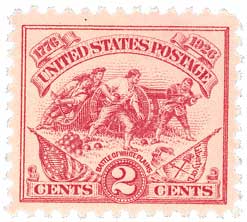
On October 28, 1776, George Washington led the 14,000–man Continental Army in the Battle of White Plains against British General William Howe’s 20,000 redcoats.
After evacuating Boston in March 1776, the British regrouped in Nova Scotia and began planning a new campaign to take over New York City. General Howe hoped to use New York to cut off New England from the rest of the colonies. That August the British landed on Long Island and defeated Washington’s troops at the Battle of Brooklyn (also known as the Battle of Long Island).
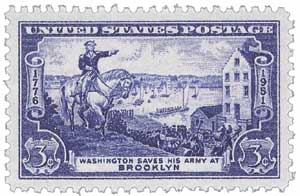
Following that battle, Washington and his men retreated while the British moved into Manhattan gave chase to the Continental Army. Their advanced was halted at Harlem Heights. In mid-October, the British began an encirclement of the Americans, aimed at trapping them between two land forces and the Royal Navy on the Hudson River.
While British General William Howe had established his camp at New Rochelle, he had advance units located just seven miles from White Plains, an under defended Continental Army supply depot. Washington discovered that the British were dangerously close to his army and the supplies and ordered reinforcements to White Plains immediately. Washington relocated to White Plains on October 23 and established three-mile long entrenched defensive position.
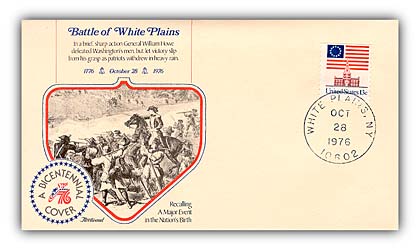
On the morning of October 28, Howe’s army marched toward White Plains. Washington was busy inspecting his lines when he received word that the British were advancing. He immediately ordered his men into position. British attempts to take the hills along the American line were initially halted. But then a Hessian artillery unit began firing on an American-held hilltop, sending the militia there into a retreat. They soon reorganized and established a defensive line, but Howe ordered a detachment to take the hill.
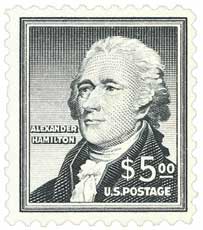
The British charged the hill, sending the Americans on the right flank scattering. Those that remained fired on the British, halting their advance. But with their flank exposed, they began a fighting retreat, which ultimately led the rest of the American line to retreat.
Alexander Hamilton positioned his canon strategically and held a large Hessian contingent at bay to allow an orderly retreat. A second German unit outflanked Washington’s men, trapping them between Howe and the Hessians. However, Howe didn’t advance and lost the opportunity to destroy Washington’s army.
As night fell, a powerful storm moved through the region. Howe ordered his troops to set up camp and artillery batteries. After two days of soaking rain and inactivity, Washington’s men slipped away during the night.
First U.S. Souvenir Sheet!
A souvenir sheet is a sheet of stamps issued to commemorate an event and carries an inscription or artwork on its border. The number of stamps on a sheet ranges from one to twenty-five or more. In the U.S., these sheets are primarily printed in conjunction with major philatelic exhibitions.
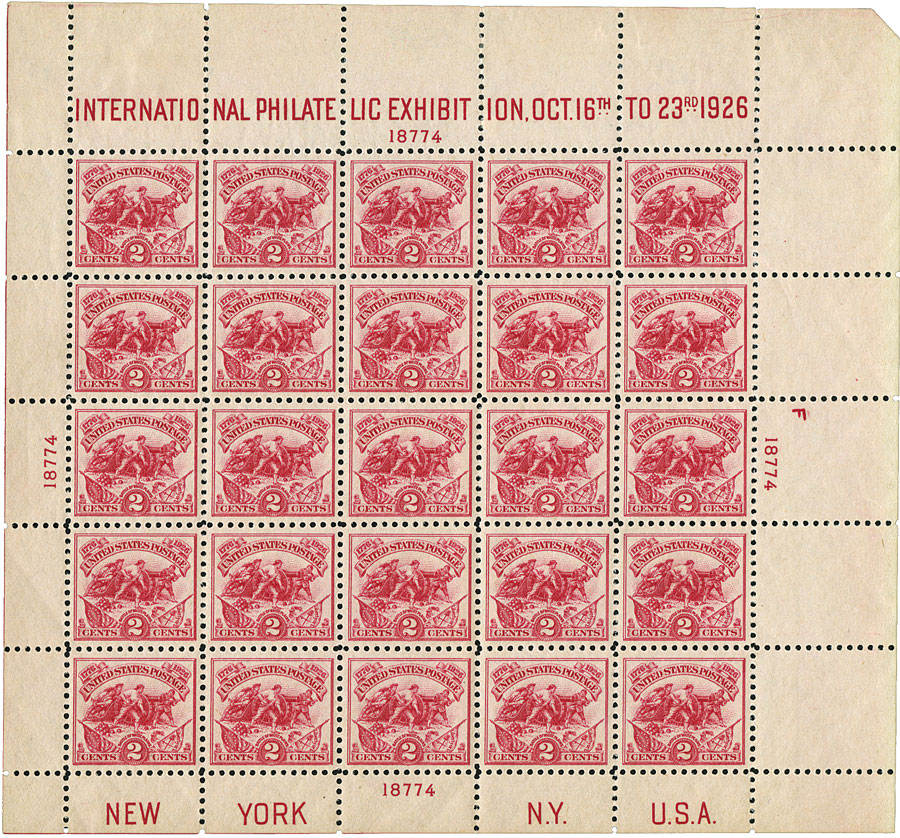
The White Plains sheet was issued for sale at the International Philatelic Exhibition held in New York from October 16-23, 1926. An inscription in the margin read, “INTERNATIONAL PHILATELIC EXHIBITION, OCT. 16-23, 1926, N.Y., U.S.A.” The sheet contained 25 of the 2¢ stamps issued to commemorate the 150th anniversary of the Battle of White Plains.
Only 107,398 White Plains sheets were printed to commemorate the International Philatelic Exhibition in 1926 – about half of 1% the normal quantity for 1920s commemoratives. In the years since, many sheets have been broken up, further reducing the supply.
Artwork Created Specially for the White Plains Stamp
The stamp’s fine engraving is based on an original painting by E.L. Ward. Ward used the 1869 30¢ stamp (#121) as the basis for his design, but with an idealized portrait of Hamilton’s battery in place of the shield. The crossed flags in the lower part of the design are a U.S. flag and a White Plains battle flag, which bears a pine tree and the inscription “Liberty or Death.” It was decided to make the flags drape in such a fashion that the word “death” would not appear on the stamp.
There was some discussion of issuing the stamp as a bi-color, but it was decided that would be too expensive. At the time, printing bi-color stamps cost 83¢ per thousand, while one-color stamps cost just 8.5¢ per thousand to produce.
Less
Most Orders Ship
within 1 Business Day
90 Day Return Policy
Satisfaction Guaranteed
Earn Reward Points
for FREE Stamps & More




